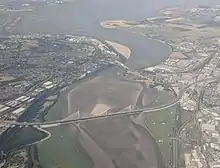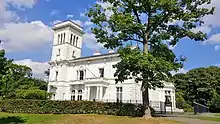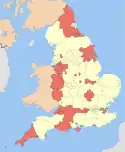Borough of Halton
Halton is a local government district in the ceremonial county of Cheshire in North West England, with borough status and administered by a unitary authority. It was created in 1974 as a district of the non-metropolitan county of Cheshire, and became a unitary authority area on 1 April 1998 under Halton Borough Council.[3] Since 2014 it has been a member of the Liverpool City Region Combined Authority. The borough consists of the towns of Runcorn and Widnes and the civil parishes of Hale, Daresbury, Moore, Preston Brook, Halebank and Sandymoor.[4] The district borders Merseyside, Warrington and Cheshire West and Chester. The borough straddles the River Mersey – the area to the north (including Widnes) is historically part of Lancashire, that to the south (including Runcorn) part of Cheshire.
Halton | |
|---|---|
 The Silver Jubilee Bridge at dusk | |
| Motto(s): Latin: Industria Navem Implet (Industry fills the ship) | |
 Halton shown within Cheshire | |
| Sovereign state | |
| Constituent country | |
| Region | North West England |
| City region | Liverpool |
| Ceremonial county | |
| Settled | 10th century |
| Incorporated | 1974 (borough) |
| 1998 (Unitary authority) | |
| Town Hall | Runcorn |
| Administrative HQ | Widnes |
| Government | |
| • Type | Unitary authority |
| • Body | Halton Borough Council |
| • Leadership | Leader and cabinet |
| • Executive | Labour |
| • Leader | Rob Polhill |
| • Mayor | Margaret Horabin |
| • Chief Executive | David Parr |
| Area | |
| • Borough | 30.53 sq mi (79.08 km2) |
| Area rank | 237th |
| Population | |
| • Borough | 129,410 |
| • Rank | 178th |
| • Density | 4,210/sq mi (1,624/km2) |
| Time zone | UTC+0 (Greenwich Mean Time) |
| • Summer (DST) | UTC+1 (British Summer Time) |
| Postcode area | |
| Dialling code | 0151 Widnes and Hale Village, 01928 Runcorn, 01925 Daresbury |
| ISO 3166 code | GB-HAL |
| GSS code | E06000006 |
| NUTS 3 code | UKD71 |
| ONS code | 00ET |
| Motorways | M56 |
| Major railway stations | Runcorn (C1) |
| MPs | Derek Twigg (L) Mike Amesbury (L) |
| Police area | Cheshire |
| Fire service | Cheshire |
| Ambulance service | North West |
| Website | www.halton.gov.uk |

History

Although Halton dates back to the 12th century (and beyond) when land on both sides of the river belonged to the Barony of Halton, the origin of the District Council was the outcome of the local government commission's suggested reforms of England, in 1969, the Redcliffe-Maud Report. This proposed to create metropolitan counties constituted of metropolitan district councils in the most urbanised parts of England. The model was that of the London Boroughs and Greater London Council formed in 1965. Southern Lancashire and northern Cheshire were among these urban areas, and two new metropolitan Counties were to be formed around Liverpool (as Merseyside) and Manchester (as Greater Manchester). However, the towns of Widnes and Runcorn (and the County Borough of Warrington) which lay between these were reluctant to join either. The Commission agreed that Halton and Warrington would become districts within Cheshire, as they would be detached from Lancashire by the two new metropolitan counties controlling the territory to the north.
The district was formally established on 1 April 1974 from Runcorn urban district and part of Runcorn Rural District from Cheshire, and the borough of Widnes and the parish of Hale from the Whiston Rural District in Lancashire. On 1 April 1998 Halton became an independent unitary authority, though it is still served by Cheshire Police and Cheshire Fire and Rescue Service, and forms part of Cheshire for ceremonial purposes, such as the Lord Lieutenancy.
On 1 April 2014 Halton became part of the Liverpool City Region Combined Authority, joining the local authorities of Liverpool, Sefton, Wirral, Knowsley and St Helens, the five metropolitan district councils which constitute the county of Merseyside. This effectively reverses the position adopted in the 1970s which created it as an anomaly. As a unitary authority its status is similar to the metropolitan district councils.[5]
Demographics
Population growth
The population of Halton is 129,410 (mid-2019 est.).[2] The change in population during the 20th century is shown in the following table.
| Year | Population | Change as % |
|---|---|---|
| 1901 | 57,755 | — |
| 1911 | 57,062 | -1.2% |
| 1921 | 61,039 | +7.0% |
| 1931 | 65,309 | +7.0% |
| 1941 | 71,835 | +10.0% |
| 1951 | 79,026 | +10.0% |
| 1961 | 87,168 | +10.3% |
| 1971 | 96,150 | +10.3% |
| 1981 | 121,861 | +26.7% |
| 1991 | 124,915 | +2.5% |
| 2001 | 118,215 | -5.4% |
| 2011 | 125,700 | +6.3% |
Religion
In the 2011 census, Christianity was the main religion in Halton at 75%, well above the national average for England of 59.4%. 18.7% stated that they had "no religion". Those stating their religions as Buddhist, Hindu, Jewish, Islam or Sikh amounted to 0.8%.[7]
Ethnicity
In the 2011 census, 97.8% of Halton residents identified as White and 2% were Non-White. From the 2011 School Census, the main first language apart from English was Polish.[7]
Governance
Halton Borough Council is a unitary authority responsible for most local government functions within the area. The Labour Party has controlled the council since it was created in 1974.[8]
On 1 April 2014, Halton became one of the six constituent local government districts of the Liverpool City Region under the Combined Authority.[9]
Most of the borough is represented in the House of Commons by the member for Halton but Runcorn New Town is in the Weaver Vale constituency.
Economy

Halton is an industrial and logistics hub with a higher proportion of people working in manufacturing (particularly chemicals and advanced manufacturing), wholesale and retail, and transport and storage compared to the average for England.[7]
| Industry | Halton (Employee Jobs) | Halton (%) | North West (%) | Great Britain (%) | Halton - Great Britain Difference |
|---|---|---|---|---|---|
| H Transportation And Storage | 7,000 | 10.8 | 5.6 | 4.9 | 5.9 |
| C Manufacturing | 8,000 | 12.3 | 9.3 | 8.0 | 4.3 |
| G Wholesale And Retail Trade; Repair of Motor Vehicles And Motorcycles | 11,000 | 16.9 | 16.3 | 15.0 | 1.9 |
| N Administrative And Support Service Activities | 7,000 | 10.8 | 8.6 | 8.9 | 1.9 |
| Q Human Health And Social Work Activities | 9,000 | 13.8 | 14.2 | 13.1 | 0.7 |
| E Water Supply; Sewerage, Waste Management And Remediation Activities | 800 | 1.2 | 0.7 | 0.7 | 0.5 |
| M Professional, Scientific And Technical Activities | 6,000 | 9.2 | 8.8 | 8.8 | 0.4 |
| S Other Service Activities | 1,500 | 2.3 | 1.9 | 2.0 | 0.3 |
| B Mining And Quarrying | 300 | 0.5 | 0.1 | 0.2 | 0.3 |
| F Construction | 3,000 | 4.6 | 4.6 | 4.9 | -0.3 |
| D Electricity, Gas, Steam And Air Conditioning Supply | 75 | 0.1 | 0.5 | 0.4 | -0.3 |
| L Real Estate Activities | 600 | 0.9 | 1.5 | 1.7 | -0.8 |
| R Arts, Entertainment And Recreation | 1,000 | 1.5 | 2.6 | 2.5 | -1.0 |
| O Public Administration And Defence; Compulsory Social Security | 2,000 | 3.1 | 4.6 | 4.4 | -1.3 |
| J Information And Communication | 1,500 | 2.3 | 2.8 | 4.3 | -2.0 |
| K Financial And Insurance Activities | 600 | 0.9 | 2.8 | 3.5 | -2.6 |
| I Accommodation And Food Service Activities | 3,000 | 4.6 | 6.9 | 7.7 | -3.1 |
| P Education | 3,500 | 5.4 | 8.0 | 8.7 | -3.3 |
The wages of employees in Halton are slightly higher than the average for England and significantly higher than the average for the North West and the Liverpool City Region.[11] Business survival rates are also significantly higher than both the regional and national averages.[11] In 2018, the GVA per head of population in Halton was £26,988 compared to a regional average of £22,244 in North West England.[12]
Twin boroughs
Halton is twinned with:
 Marzahn-Hellersdorf, Germany (since 25 May 1993)
Marzahn-Hellersdorf, Germany (since 25 May 1993) Ústí nad Labem, Czech Republic (since 13 October 1993)
Ústí nad Labem, Czech Republic (since 13 October 1993) Leiria, Portugal (since 1997)
Leiria, Portugal (since 1997) Tongling, China (since 1997)
Tongling, China (since 1997)
Following an appeal in 1997, Halton residents donated 1,000 English books to Jan Evangelista Purkyně University in Ústí nad Labem.[13] In 1999, an historic Halton Transport bus was restored and gifted to the Czech Republic to mark the centenary of public transport in the city.[14] Engineers from Halton have assisted with chemical decontamination in the city and also when the city flooded in 2002.[15]
The first crazy golf course in Berlin, created in Marzahn-Hellersdorf in 2005, contains several Halton landmarks and was constructed with the assistance of exchange students from the borough.[16]
Several roads are named after Halton's twin boroughs, including Leiria Way in Runcorn and Marzahn Way in Widnes.[17] A Chinese friendship garden was created in the grounds of Runcorn Town Hall in 2006, including a bronze statue gifted by the twin city of Tongling.[18]
See also
References
- "Standard Area Measurements (2016) for Administrative Areas in the United Kingdom". Office for National Statistics. 1 February 2017. Retrieved 9 February 2017.
- "Population Estimates for UK, England and Wales, Scotland and Northern Ireland, Mid-2019". Office for National Statistics. 6 May 2020. Retrieved 6 May 2020.
- "Unitary Authority". Halton Borough Council. Archived from the original on 22 September 2008. Retrieved 19 January 2009.
- "Parish Councils". Halton Borough Council. Retrieved 19 July 2018.
- Clay, Oliver, Halton to become part of Liverpool city region, Runcorn & Widnes Weekly News, archived from the original on 27 July 2011, retrieved 15 January 2009
- "Halton UA through time - Population Statistics". University of Portsmouth. Retrieved 20 July 2020.
- "2011 Census Halton key statistics profile" (PDF). Halton Borough Council. Retrieved 23 June 2018.
- "Halton". BBC News Online. 19 April 2008. Retrieved 3 March 2010.
- "Proposal to establish a combined authority for Greater Merseyside" (PDF). Department for Communities and Local Government. November 2013. Retrieved 10 December 2013.
- "Labour Market Profile - Halton". Office for National Statistics. Retrieved 20 November 2020.
- "Halton Borough Profile" (PDF). Halton Borough Council. Retrieved 19 July 2018.
- "Economic Assessment and Halton 2030" (PDF). Halton Borough Council. 24 September 2018. Retrieved 7 October 2020.
- "Thanks to Halton". Warrington Guardian. Newsquest Media Group Ltd. 8 April 1997. Retrieved 2 November 2020.
- "Halton - Ústí nad Labem City Hall". Ústí nad Labem City Council. Retrieved 2 November 2020.
- "Forgiving but not forgetting Czechs' war". Cheshire Live. Reach plc. 19 May 2005. Retrieved 2 November 2020.
- "Golf course putts Halton on the map". Cheshire Live. Reach plc. 25 August 2005. Retrieved 2 November 2020.
- "Going Deutsche". Warrington Guardian. Newsquest Media Group Ltd. 21 July 2004. Retrieved 2 November 2020.
- "Friendship garden is full of Eastern promise". Cheshire Live. Reach plc. 22 June 2006. Retrieved 2 November 2020.



